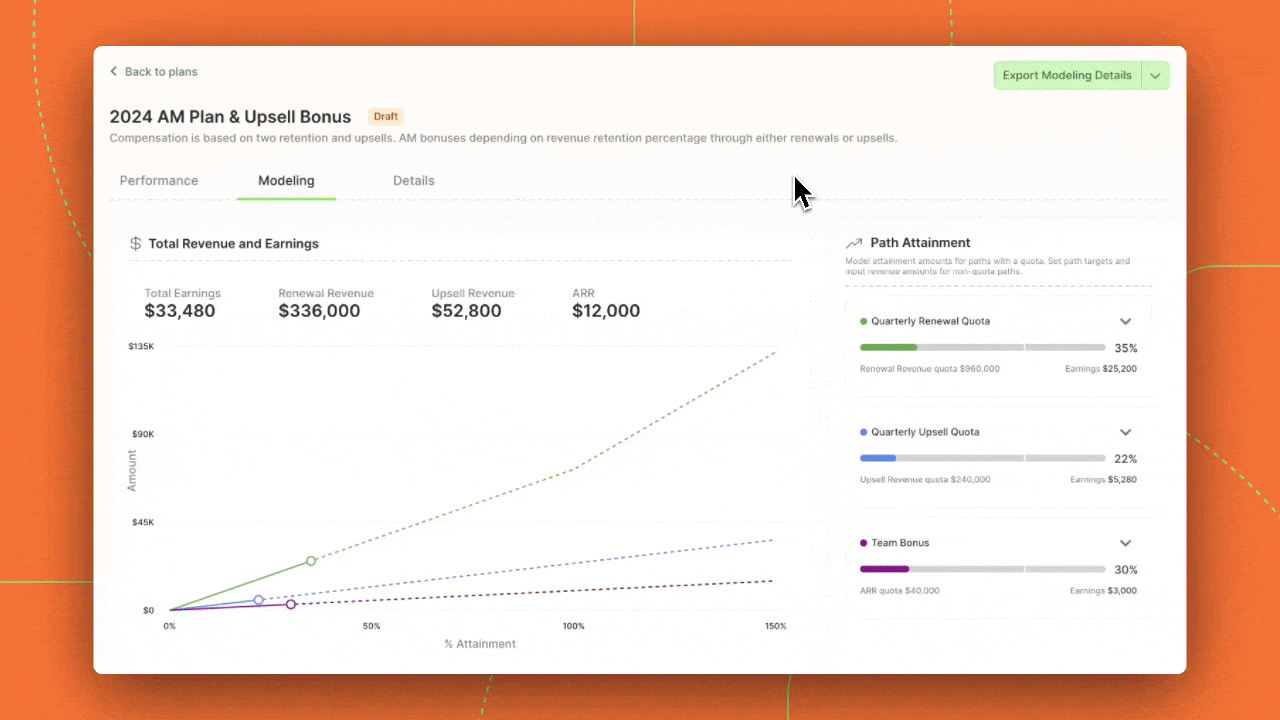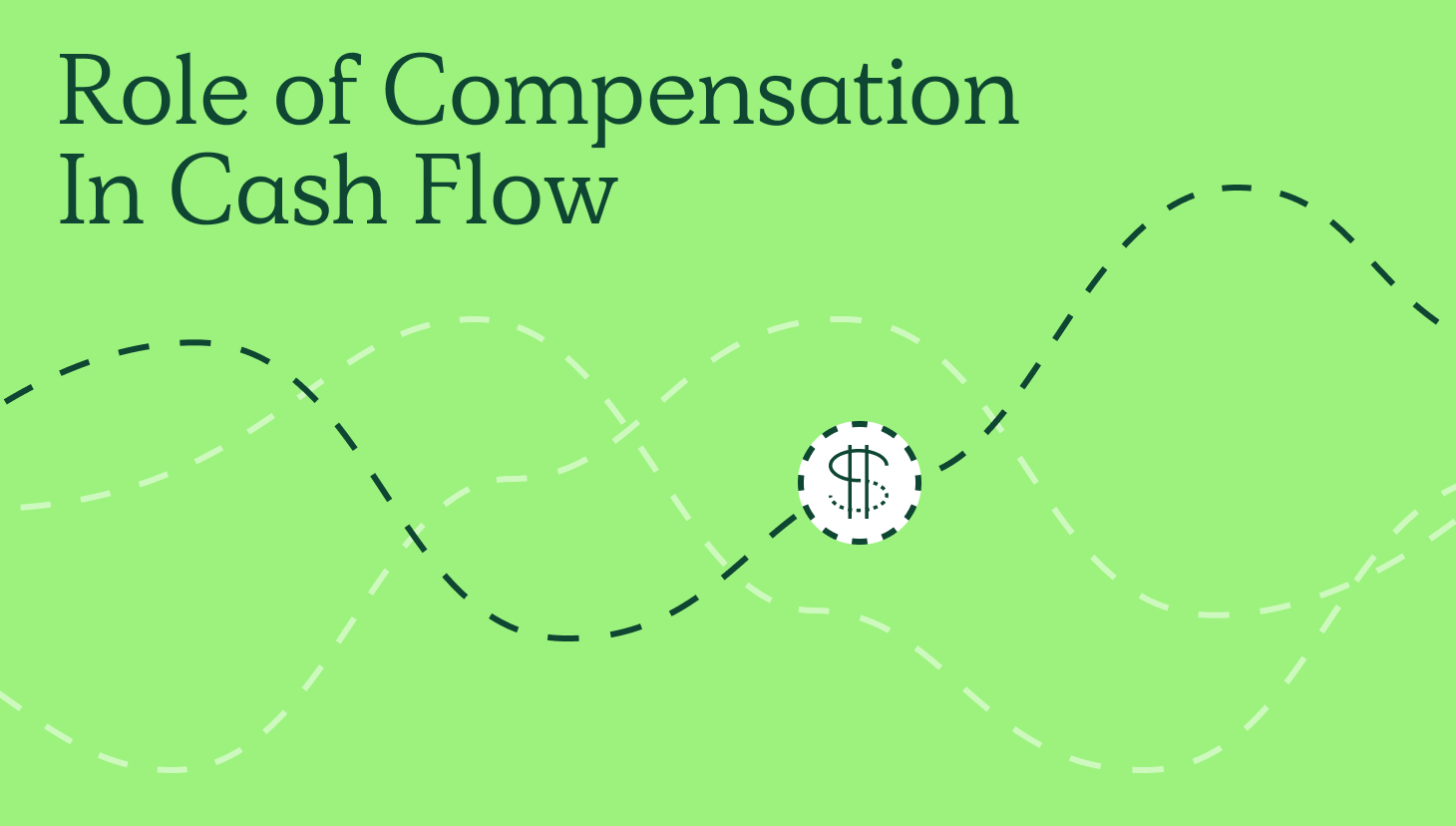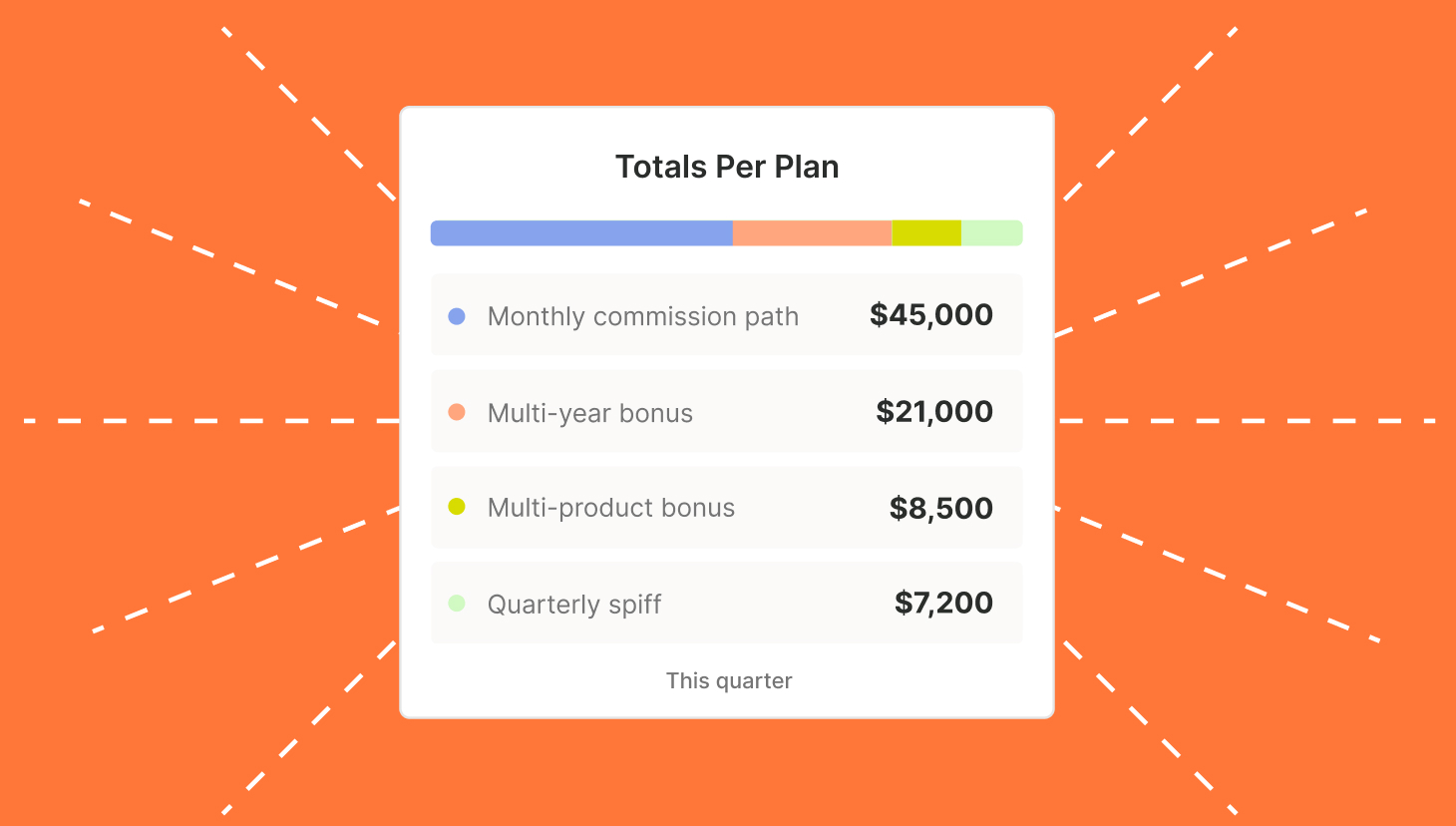Strategic compensation planning refers to the deliberate and thoughtful process of designing and managing an organization’s compensation structure and policies in alignment with its overall business strategy and objectives.
This process involves creating an incentive structure that attracts, retains, motivates, and rewards employees while supporting the company’s growth, profitability, and competitiveness goals.
It’s essential to business goal achievement — and many agree.
According to a ZS and Reality Works study, 79% of tech companies and 90% of non-tech large companies use quota-driven sales compensation plans.
Draft, Test, and Model Comp Plans
Use QuotaPath to draft comp plans and test them against histortical pipeline data to see various team attainment levels and approximate costs of compensation. Then, use Plan Performance Modeling within QuotaPath to forecast your new plan’s potential cost and revenue value dynamically based on your attainment predictions.
Learn MoreBy carefully designing and implementing effective plans, companies can achieve their sales goals, attract and retain top talent, and gain a competitive edge in the market. Conversely, getting the strategy behind a comp plan wrong could lead to missing organizational targets.
Our 2024 Compensation Study found that 91% of organizations missed their targets in 2023. Of the 450+ revenue leaders surveyed, 35% cited their organization’s miss to misaligned sales activities. Another 30% admitted they set unrealistic goals.
We want to help demystify the compensation planning process.
In our guide below, you’ll learn:
- What strategic compensation planning is and why it’s more effective than traditional methods at driving organizational objectives.
- The role of automation in compensation planning and its benefits.
- The key elements of an effective compensation plan.
- How QuotaPath streamlines and facilitates the strategic compensation planning process.
- Compensation plan development challenges and why they occur.
- Best practices in compensation plan design for successfully navigating the planning process.
- How to leverage data to measure your compensation plan’s success, identify improvement opportunities, and make adjustments.
Let’s get started.
Understanding Strategic Compensation Planning
Strategic compensation planning is more than deciding how to reward your employees for their efforts. It involves intentionally tailoring compensation to business goals by incentivizing sales rep behaviors that support their achievement.
“Compensation plans should be the caboose, not the engine,” said Pablo Dominguez, Operating Partner, Sales & Customer Success at Insight Partners.
That means focusing first on what you want the company to accomplish. Then, you can collaborate on the plans with Finance, RevOps, and Sales to model them based on those goals.
This approach drives profitability, growth, and employee satisfaction while achieving organizational targets.
Traditional methods of compensation planning end up working against business goal achievement by rewarding the wrong behaviors.
For example, a traditional single-rate compensation plan that pays a flat percentage for every single deal fails to provide reps with deal prioritization.
However, strategic compensation planning may involve structuring a plan that rewards a higher rate for accounts that fall under an ideal customer profile because those customers are most likely to renew and realize total value.
Although aligning incentives with company goals drives desired behaviors and organizational goals concurrently, 39% of leaders admit that their plans don’t align with business targets.
This is problematic as compensation impacts employee morale, engagement, and performance. Companies with clear and transparent compensation plans experience 54% higher employee morale. Studies also show that transparency increases employee retention, while unclear or unfair compensation can decrease employee morale and productivity.
Why is Strategic Compensation Planning Important?
Without a deliberate approach to compensation, companies risk creating plans that don’t align with core business objectives, leading to unintended and often counterproductive outcomes. When incentives don’t match up with company goals, sales teams may focus on activities that don’t drive growth, retention, or profitability. For example, without strategic planning, a flat-rate commission structure could encourage reps to prioritize quick, one-time deals instead of building long-term, high-value customer relationships. This misalignment can ultimately hurt customer loyalty and business stability.
Additionally, compensation plans that lack clarity or transparency can harm employee morale.
When reps don’t fully understand how their efforts translate into earnings—or worse, if they feel the plan is inconsistent or unfair—they are more likely to disengage. This disconnect affects individual motivation and can lead to high turnover, with top performers seeking companies that offer clearer and more meaningful rewards.
Another downside is the loss of competitive edge.
Top talent has options today, and organizations without well-aligned, motivating compensation plans will struggle to attract and retain high-performing salespeople. Over time, this talent gap can impact everything from team productivity to market share.
Finally, the lack of strategic compensation planning often leads to missed organizational targets.
When compensation plans fail to drive the behaviors necessary for achieving business goals, it becomes much harder to meet revenue, retention, or profitability targets. This misalignment can create a cycle of underperformance, where leadership must constantly revise goals and sales strategies to compensate for the shortcomings of an ineffective incentive structure.
In short, without strategic compensation planning, companies face the risks of misaligned priorities, reduced morale, high turnover, weakened competitive standing, and the potential to miss critical business goals.
The Role of Automation in Compensation Planning
Automation tools can streamline planning, reduce errors, and increase efficiency. Unlike commission spreadsheets, automation eliminates time-consuming, faulty manual input, formulas, and calculations.
These platforms facilitate data analysis, scenario modeling, and plan simulation, enabling you to estimate annual incentive earnings, calculate revenue potential and commission costs, and quickly run attainment scenarios.
This frees up time for strategic decision-making and boosts confidence that your new plan structure is fair, logical, and effective.
Key Elements of an Effective Compensation Plan
The fundamentals of a strategic compensation framework include:
Market Competitiveness
Benchmarking against industry standards is essential to creating a market-competitive compensation plan. This enables you to attract top talent as well as motivate and retain current team members. We recommend Betts Compensation Guide for industry standards.
Goal Alignment
Individual and team goals must be linked to broader company objectives through metrics and KPIs. For instance, if a business’s priority is to increase gross revenue retention, then incentives need to reward behaviors that support the achievement of this outcome.
Pay Mix Structure
People are motivated by various means. So, it’s essential to use a balanced pax mix of base salary, bonuses, and incentives so the compensation plan motivates the desired behaviors and performance while inspiring team members to go the extra mile.
Transparency & Communication
Clearly and simply communicating the new sales compensation plan is essential to its success. Explain the details in simple language and various formats, including commission calculations, performance metrics, and payout rules. When employees understand the plan and any changes, you’re more likely to get their buy-in and active participation. This ultimately drives desired behaviors and business outcomes.

Compensation Plan Templates
Discover, compare, build, and customize plans using one of our 20 adjustable compensation plan templates.
Explore TemplatesStrategic Compensation Plan Examples
For inspiration, check out a few examples of strategic compensation plans below.
Each one is designed to align rep incentives with specific company objectives, from growth and customer retention to successful new product launches. By choosing the right plan, companies can effectively guide their sales teams to focus on what matters most, achieving results that support individual and organizational success.
1. Tiered Commission Plan for High-Value Accounts
- Objective: Drive focus on high-value or ideal customer profiles (ICPs) that are more likely to convert into long-term, profitable customers.
- Structure: In a tiered commission plan, reps earn higher commission rates for deals that match specific ICP criteria, such as industry, company size, or geographic location. Lower-tier deals, such as those outside of these criteria, yield a smaller commission.
- Benefits: This plan encourages reps to prioritize deals with high-value potential, resulting in more valuable accounts and greater customer lifetime value for the company. It’s especially useful for businesses aiming to build a loyal customer base that aligns with long-term growth objectives.
2. Accelerated Rate for Over-Quota Performance
- Objective: Motivate sales reps to consistently exceed their targets and boost overall sales productivity.
- Structure: Once a rep reaches their quota, they move into an accelerated commission tier where they earn a higher percentage on each additional sale. This tiered accelerator can increase further as reps exceed specific benchmarks, such as 125% or 150% of quota.
- Benefits: This structure incentivizes reps not just to meet their goals, but to push beyond them. It’s ideal for companies looking to increase sales velocity and reward top-performing reps, while ensuring that the most productive salespeople see substantial financial rewards.
3. Milestone-Based Bonuses for New Product Sales
- Objective: Promote adoption and success of a new product or service.
- Structure: Reps receive milestone bonuses when they reach specified sales targets for a newly launched product, which could include bonuses at the first sale, after reaching ten sales, or achieving a set revenue goal.
- Benefits: This approach encourages reps to prioritize the new offering, giving it early traction in the market. It also helps the company capture valuable data and market feedback, which is often crucial during a product’s initial rollout phase.
4. Annual Retention Bonus for High Customer Retention Rates
- Objective: Drive customer retention and increase revenue from renewals or upsells.
- Structure: Reps earn a bonus at the end of the year if a significant percentage of their accounts renew or if they maintain a low churn rate within their portfolio.
- Benefits: This plan is ideal for companies that want to reduce churn and improve customer relationships. By incentivizing retention, reps are encouraged to focus on client satisfaction and upsell opportunities, directly supporting long-term revenue goals.
5. Cross-Selling and Upselling Incentives
- Objective: Increase revenue per customer by expanding product penetration across existing accounts.
- Structure: Reps receive additional commissions or bonuses for each successful cross-sell or upsell to current customers. This can be structured as a flat bonus per additional product sold or as a percentage increase in their total commission rate.
- Benefits: By rewarding cross-selling and upselling, this plan maximizes the potential value of each customer account and deepens customer relationships. It’s highly effective for SaaS or subscription-based companies that benefit from a broader product adoption within their existing customer base.
QuotaPath’s Approach to Compensation Planning
QuotaPath is a powerful software solution for designing high-performing comp plans, managing sales compensation, and providing insights into plan and team performance. This platform supports the entire compensation planning process and streamlines payouts of commissions.
Ensure you’re offering market competitive compensation with our free Quota:OTE ratio calculator. This tool verifies your on-target earnings and quotas align with industry averages.
Confirm goal alignment by running plan scenarios with QuotaPath’s compensation modeling features. This allows you to perform a compensation plan analysis before implementation and adjust it proactively.
Automate commission calculations for error-free paychecks so you can confidently include a mix of performance-based incentives to motivate behaviors that drive company objectives.
Increase transparency and communication of new or revised comp plans by providing your sales team with QuotaPath’s free commission calculators, allowing them to run what-if scenarios for deals in their funnel. Then, streamline the plan verification process to confirm employee understanding and buy-in.
EverView is an excellent example of how these tools simplify the employee compensation management process.
Before partnering with QuotaPath, EverView had 35 compensation plans for a sales team of 80. Fifty percent of their sellers reported not understanding their comp plan and had no idea how much they had earned until they received their paychecks.
After implementing QuotaPath, EverView consolidated their 35 plans into eight and then to 1 in QuotaPath. Sellers could measure plan attainment and current or future earnings at any time. This led to EverView having its highest sales year, with 70% of the team hitting quota and 20% achieving 90%.
Challenges in Compensation Plan Development
We surveyed over 450 Finance, RevOps, and Sales leaders across SaaS to identify the top pain points regarding sales compensation. Surprisingly, 97% of these executives reported challenges.
Unrealistic expectations were cited as a top challenge by 19% of leaders. Setting excessively high quotas and on-target earnings (OTEs) that are unattainable sets your team up for failure and often results in sales rep churn.
Failure to motivate reps was reported by 19% of surveyed executives. Although using the wrong mix of incentives is one reason a compensation plan falls short, a lack of understanding is often the problem. That’s why leveraging an effective compensation communication plan so reps understand how they earn commissions helps prevent reps from getting demotivated or frustrated.
Too complex to execute well was a challenge specified by 18% of participants. Overly complex comp plans contain too many compensation elements. These plans are labor-intensive to execute well and maintain.
Too complicated to understand was identified as a top compensation challenge by 17% of those surveyed. Plans that are overly elaborate leave reps overwhelmed and confused, making it unclear where to focus their efforts.
Failure to drive customer acquisition cost efficiency (CAC) was cited as a compensation challenge by 14% of leaders. Plans that aren’t optimized to drive CAC affect the efficiency of your growth engine like marketing spend, sales capacity, and management overlay.
Best Practices in Compensation Plan Design
These compensation planning process best practices will help prevent significant mistakes while increasing plan success.
Regular Reviews & Updates: Compensation planning is not a set-it-and-forget-it sort of process. Routinely revisit and adjust the plan based on performance and market changes.
Employee Feedback & Involvement: Incorporate employee input during the planning process by surveying reps, engaging them on a Slack channel, or during 1-on-1 meetings. Ask what motivates them, how well they understand the plan, and how they’d change or add to it. Then, incorporate employee suggestions or explain why something isn’t feasible.
Data-Driven Decision Making: Base compensation decisions on data and objective metrics rather than gut feeling or emotion. Using historical performance data, industry insights, and modeling projections is best to make educated compensation decisions.
Measuring the Success of Your Compensation Plan
An essential element of the strategic compensation planning process is measuring the success of your plan through the lens of employee retention, performance, and compensation-related costs, also known as effective rate.
Track these metrics with compensation reporting tools like dashboards, integrated software like QuotaPath, or manually gather data from various systems into spreadsheets for analysis.
There are various ways to analyze the data to evaluate the plan’s effectiveness. For example, start with quota attainment. 80% of your team should hit their quotas. If you’re considerably below 80%, getting to the root cause, such as closing skills, leads, or motivation, is essential.
Verify that the quotas and OTEs are realistic and in line with industry trends. You can measure this with our free Quota: OTE Ratio Calculator.
Unrealistic goals, especially in the current economic environment, set your team up to fail. This leads to frustration and discouragement and could ultimately cause reps to quit.
Resolve unrealistic quotas and OTEs by decreasing quotas and better aligning them with OTEs so reps don’t get discouraged. You can also increase motivation and yield quick wins by adding logo commissions and other SPIFs.
If you find a significant difference between commissions and goal achievement for your weakest and best-performing team members, figure out why. This often stems from unbalanced comp plans or territories. Adjust them to ensure they are fair and proportionate for all employees.
Are you paying high commissions to a team falling short of their targets? It may be time to establish minimum performance requirements before reps can earn commissions. A commission floor accomplishes this and motivates quota-carrying employees to hit goals while preventing the business from rewarding underperformance.
Complete this process periodically to identify areas for improvement and refine the plan over time.
Streamline commissions for your RevOps, Finance, and Sales teams
Design, track, and manage variable incentives with QuotaPath. Give your RevOps, finance, and sales teams transparency into sales compensation.
Talk to SalesApproach Compensation Planning Strategically
Strategic compensation planning is essential to business success. It affects employee motivation, retention, and the company’s ability to achieve organizational goals.
Strategic planning involves intentionally tailoring compensation to business goals and incentivizing sales rep behaviors that drive their achievement. This approach is significantly more effective than traditional methods that often work against hitting business goals.
Automation tools streamline the planning process, increase efficiency, and reduce errors. They facilitate data analysis, plan simulations, and modeling, enabling data-driven, strategic decision-making while boosting confidence in new plans.
An effective strategic compensation planning process considers market competitiveness, goal alignment, pay mix structure, and leverage clear and effective communication. Leverage these elements to increase plan success.
QuotaPath is a powerful software solution for designing high-performing comp plans, managing sales compensation, and providing insights into plan and team performance. Providing support throughout the planning process, including employee compensation management, our platform includes many useful tools to calculate the Quota:OTE ratio, model compensation, commission calculators, and plan verification automation.
Our recent survey revealed the top sales compensation challenges of leaders across SaaS include unrealistic expectations, failure to motivate reps, overly complex plans, plans too complicated to understand, and failure to drive CAC. You can avoid these challenges by leveraging a strategic compensation planning process.
Conduct regular reviews and updates, gather employee feedback and involve them in the process, and leverage data for more informed decision-making as you build compensation plans to increase the success of your compensation planning process.
Strategic compensation planning is cyclical. It involves creating a plan, measuring its effectiveness, and refining it. During reviews, identify weaknesses and areas for improvement so you can adjust and improve your plan over time.
You can start developing effective compensation plans by:
- Identifying organizational goals
- Selecting business targets that specific behaviors can directly impact.
- Tailoring compensation and incentives to these business goals
- Testing the plan to ensure it is financially sound.
- Using an effective compensation communication plan to increase understanding and buy-in across the organization.
- Measure compensation plan success, leveraging data to identify areas for improvement.
Whether you are designing compensation plans with a strategic mindset or need performance metrics and insights to assess team output or your plan’s success, QuotaPath is your partner for strategic compensation planning success.







